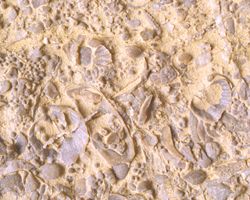Rock (geology)
In geology, a rock is a natural aggregate of minerals. Rocks constitute the lithosphere, that is, the part of our planet below the soil.
Classification

Rocks can be classified based on their origin. There are thus three main groups of rocks:
- Sedimentary rocks are formed at the earth's surface by sedimentation of fragments of previously existing rocks, or by chemical precipitation. Most sedimentary rocks are marine.
- Igneous rocks are formed from the solidification of melts, i.e., magmas or lavas. When an igneous rock is formed within the crust, it is called an intrusive rock. Subvolcanic rocks are formed within the crust, but very close to the surface, and exhibite textures similar to those of volcanic rocks. Finally, igneous rocks formed from the solidification of lavas, either on dry land or under the sea, are called volcanic rocks.
- Metamorphic rocks are formed within the crust by the textural and mineralogical modification of a previous rock, under high pressure and/or high temperature conditions.
Sedimentary rocks
Sedimentary rocks are produced at the earth's surface, or after a relatively shallow burial, mostly through two processes: by lithification of fragments of a pre-existing rock, or by chemical precipitation from a supersaturated solution. The rocks produced by the first of these processes are called clastic, and those produced by precipitation, chemical sedimentary rocks. Petroleum and Bitumen are also considered sedimentary rocks, produced by the accumulation and diagenesis of organic matter.
Clastic rocks
Chemical rocks
Most chemical rocks are produced by precipitation of calcium carbonate from seawater supersaturated with respect to CaCO3. This process is responsible for the formation of most limestones.
Chemical Sedimentary Rocks:
- Limestone
- Dolomite (or dolostone)
- Chert, Flint or Radiolarite
- Travertine
- Gypsum
- Halite